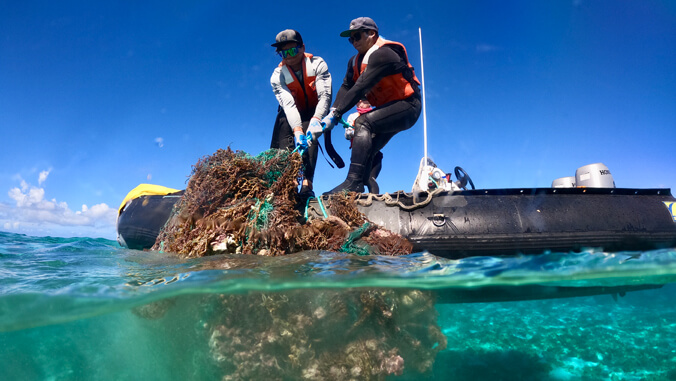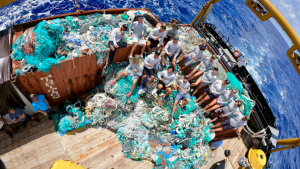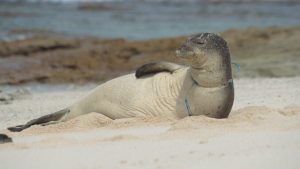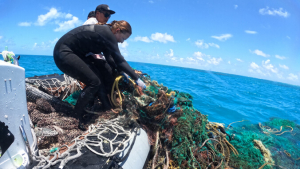
To address rampant marine debris issues in Hawaiʻi and develop urgently needed, innovative solutions that can be shared worldwide, the University of Hawaiʻi Sea Grant College Program (Hawaiʻi Sea Grant) and its partners were awarded $5,120,959.
The funding will primarily focus on derelict fishing gear that has been abandoned, lost or discarded. This kind of debris devastates threatened and endangered species such as Hawaiian monk seals, sea turtles and humpback whales; harms commercial and recreational fisheries; poses a hazard to shipping and boating; pollutes the shoreline and nearshore waters; and is a health hazard to humans and other animals.

This investment from the National Sea Grant College Program will connect visionary experts from across the state and region in three multi-year projects to increase the efficiency of derelict fishing gear removal, repurpose the gear that is brought to shore and engage a network of community members and resource managers throughout the Pacific to develop a regional Pacific Islands Marine Debris Action Plan.
“It is an honor to be partnering on these projects with researchers, cultural practitioners, industry members, and other experts from all across the state to tackle a problem that has had profound negative impacts on the environment, the economy and the health of our communities,” said Darren T. Lerner, Hawaiʻi Sea Grant director and principal investigator of two of the grants. “While Hawaiʻi and the Papahānaumokuākea Marine National Monument are known worldwide as hotspots for ocean plastic pollution and environmental damage, the cutting-edge technologies that will be developed through these large grants will have far-reaching impacts on other states and nations impacted by ocean plastic pollution.”
“Development of New Cutting and Lifting Technologies to Increase Efficiency of Derelict Fishing Gear Removal” ($1,830,345)

The focus of this project is to improve the detection of the nets; develop innovative tools to cut the net masses which have been known to weigh up to 11 tons each and are now cut and brought onto boats by hand; and develop new technologies and techniques for lifting the nets out of the water. Since in-water marine debris removal was initiated in 1996, a staggering 2.4 million pounds of debris have been removed from within the boundaries of Papahānaumokuākea alone, and the applicant organization, the Papahānaumokuākea Marine Debris Project (PMDP), now spearheads marine debris removal efforts in this area. It aims to remove the annual debris accumulation as well as address the backlog which is now impacting coral reefs and thousands of marine and terrestrial species.
The principal investigator is Lerner and the co-principal investigators are Kevin O’Brien and James Morioka from the PMDP, and Mary J. Donohue and Darren Okimoto from Hawaiʻi Sea Grant.
“Papahānaumokuākea has one of the heaviest marine debris accumulation rates in the world, so our region is the perfect testbed to develop new tools and processes to push the boundaries of existing marine debris removal approaches,” said O’Brien, PMDP’s founder and president. “Successful breakthrough solutions for net cutting and lifting would change the current landscape of marine debris removal operations and could be utilized worldwide by organizations struggling to remove large nets from difficult locations.”
“Nets to Roads: Innovative research to scale-up removal and repurposing of derelict fishing gear” ($2,990,627)

This project will focus on all aspects of the issue, from detecting the debris at sea and forecasting its arrival in Hawaiʻi’s nearshore waters; rapid removal and transport to a centralized storage facility from anywhere around the state; sorting and repurposing the debris into plastic pellets that are compatible for use in asphalt roads in partnership with the Hawaiʻi Department of Transportation. Ultimately, the goal is to recycle 40 tons of ocean plastic each year for use in asphalt roads in Hawaiʻi. A large emphasis of the project will be on research and education at each step of the process. The principal investigator is Lerner and the co-principal investigators are Jennifer Lynch and David Horgen from Hawaiʻi Pacific University and Donohue and Okimoto from Hawaiʻi Sea Grant.
“Like two links in a chain, this project will propel the multiple steps of removal to repurposing plastic marine debris,” said Lynch, co-director of Hawaiʻi Pacific University’s Center for Marine Debris Research and biologist with the National Institute of Standards and Technology. “As a major win-win for the environment and the residents of Hawaiʻi, the funding will formally bring together some of the most impactful marine debris researchers and removal non-profit organizations that have for decades interacted within the Hawaiʻi Marine Debris Action Plan, while also linking their efforts towards an innovative long-term repurposing idea that can make Hawaiʻi’s public road infrastructure more sustainable.”
“Pacific Islands Marine Debris Community Action Coalition” ($299,987)
Fishing communities in Hawaiʻi and the U.S-affiliated Pacific Islands have unparalleled physical and cultural connections to the ocean but are some of the most impacted globally in the context of marine debris. Efforts to mitigate this problem have been limited historically, so this project will connect communities who have not been traditionally engaged to address marine debris with nonprofit organizations, government agencies and academic institutions to develop a regional Pacific Islands Marine Debris Action Plan.
The principal investigator is Eileen Nalley and the co-principal investigators are Lerner, Elizabeth A. Lenz, and Donohue from Hawaiʻi Sea Grant.
“We’re really excited to work with partners in American Samoa, the Federated States of Micronesia, Guam, Hawaiʻi and the Republic of the Marshall Islands to scale up an approach that has been successful locally through the development of a regional Marine Debris Community Action Coalition,” said Nalley, Hawaiʻi Sea Grant’s ocean and coastal ecosystem health specialist. “This project will improve knowledge sharing, facilitate collaboration, and increase capacity throughout the region for addressing problems related to marine debris.”
“Critically, the intersection of these three projects and integration of efforts across them will drive innovation at a scale not before possible in Hawaiʻi or anywhere in the world,” said Donohue, Hawaiʻi Sea Grant program development and national partnership specialist. “Hawaiʻi Sea Grant is partnering with the most imaginative and talented researchers, practitioners, communities and other partners to both remove and repurpose this very harmful type of ocean plastic pollution. The projects in and of themselves are brilliant, but together they constitute a unique opportunity to significantly advance our ability to mitigate derelict fishing gear.”
—By Cindy Knapman

